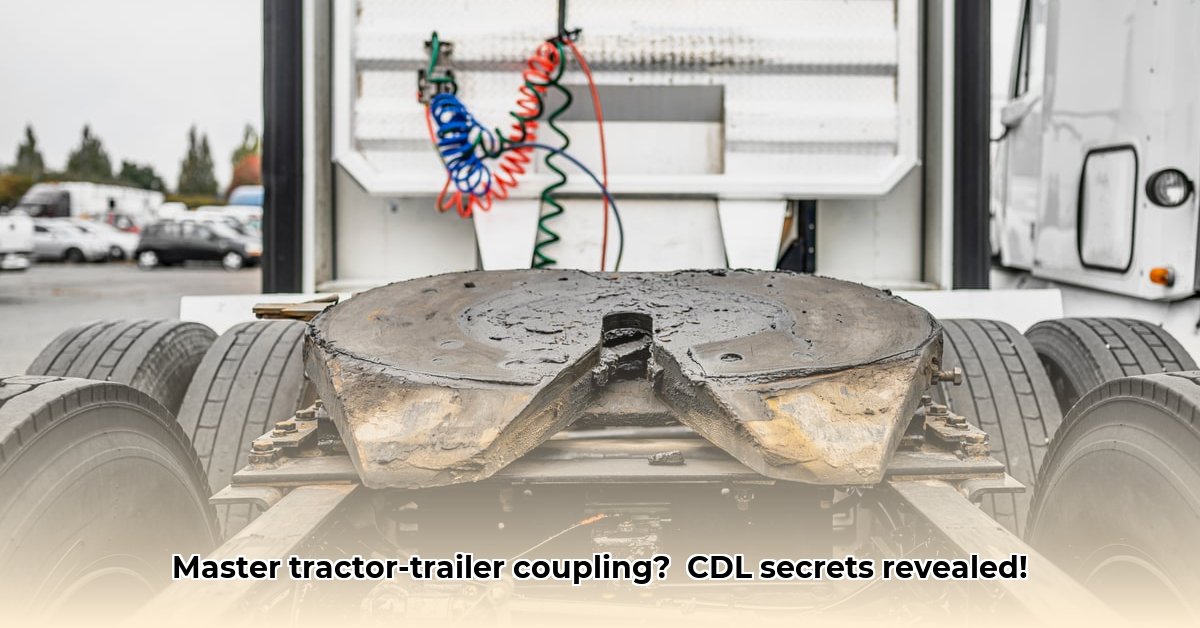
Hitting the road with a fully loaded rig demands mastery of coupling and uncoupling your tractor and trailer. This guide provides a step-by-step process emphasizing safety and efficiency for all CDL drivers, from seasoned professionals to those just starting out. For more advanced troubleshooting, see our detailed guide.
Before You Hook Up: The Pre-Coupling Inspection
A thorough pre-connection inspection is crucial for safety. Skipping this step is like flying without a pre-flight check—risky and potentially disastrous. Before beginning, meticulously inspect:
Fifth Wheel: Examine for damage, cracks, or wear on the kingpin and plate. Ensure the locking mechanism functions perfectly; a faulty mechanism can cause catastrophic trailer separation.
Trailer Landing Gear: Verify the landing gear is fully retracted and securely locked. Failure to fully retract the legs risks damage to the connection and even a rollover.
Braking System: Test the trailer brake system to ensure it’s fully operational. Non-functional brakes present a major safety hazard.
Lighting System: Confirm all lights and signals function correctly. This is vital for communication with other drivers, especially at night or in low visibility.
Coupling System: Inspect the entire coupling mechanism: fifth wheel, pintle hook (if applicable), safety chains, and all components. Look for wear, damage, or missing parts.
Tires: Visually inspect all tires on both the tractor and trailer, checking for uneven wear, cuts, bulges, or low tire pressure. Proper inflation is crucial for safe handling. Did you know that underinflated tires account for a significant percentage of trucking accidents?
Connecting the Units: The A.I.M. Method
The A.I.M. method—Align, Inspect, Mate—provides a systematic approach for secure coupling.
Alignment: Carefully back your tractor to the trailer, positioning the fifth wheel directly over the kingpin. Precise alignment is essential to prevent damage and ensure a stable connection. Improper alignment dramatically increases the risk of accidents.
Inspection: After initial alignment, step back and visually re-check that the fifth wheel is perfectly centered. Even small misalignments can cause problems.
Mating: Gently lower the fifth wheel onto the kingpin. You should hear a secure click as the kingpin nests. Never force the connection; forcing can cause serious damage. If it doesn't connect smoothly, stop, identify the problem, and rectify it before proceeding.
Post-Coupling: Verification Before Rollout
After connecting, perform a complete post-coupling check:
Visual Inspection: Walk around the rig, meticulously inspecting all connections, lights, and components. A quick glance is insufficient; every connection point must be checked.
Air and Electrical Systems: Confirm all air and electrical connections are secure and leak-free. Air leaks reduce braking capacity.
Safety Chains: Verify safety chains are securely connected, untwisted, and untangled. Properly connected safety chains are essential in case of accidental disconnection.
Brake Test: Retest the trailer brakes to ensure they function correctly after coupling. Even a minor problem can escalate quickly.
Disconnecting Safely: The D.R.O.P. Method
The D.R.O.P. method—Deploy, Roll, Release, Observe, Pause—ensures safe and controlled uncoupling.
Deploy: Position your truck for a safe disengagement path. Choose a level, stable area for uncoupling.
Roll: Engage the trailer landing gear and ensure it fully settles under the trailer's weight.
Release: Slowly and carefully disengage the fifth wheel from the kingpin. Avoid sudden movements.
Observe: Visually confirm the fifth wheel is completely clear of the kingpin. Ensure a complete disconnect.
Pause: Wait briefly to ensure all parts remain stable and secure. This prevents accidental damage.
Maintaining Your Rig for Seamless Coupling
Regular maintenance is crucial for safe and efficient coupling/uncoupling.
Routine Inspections: Regularly check your fifth wheel, landing gear, and all coupling components. Schedule inspections as part of preventative maintenance.
Lubrication: Keep moving parts lubricated to prevent wear, increase lifespan, and reduce failure risk. Proper lubrication facilitates easier coupling and uncoupling.
Professional Servicing: For complex repairs or maintenance, consult professional truck mechanics. This ensures your rig's safety and functionality.
How to Troubleshoot Tractor Trailer Uncoupling Problems
Safe uncoupling requires attention to detail and adherence to procedures. Regular inspections prevent issues, and understanding your equipment is crucial for troubleshooting. A systematic approach simplifies complex situations.
Pre-Uncoupling Inspection: The First Line of Defense
Before disconnecting, perform a thorough pre-uncoupling inspection; it’s your first line of defense against unforeseen problems. Check lights, brakes, air pressure—is everything functional? This prevents major issues later.
Common Uncoupling Challenges and Their Solutions
Many uncoupling problems stem from simple oversights.
Fifth Wheel Won't Release: Ensure the release handle is fully engaged, the locking mechanism is disengaged, and the kingpin is correctly seated. Gently rock the tractor if stuck. If the problem persists, seek assistance.
Air Lines Won't Disconnect: Ensure the air lines are correctly aligned and locks are released before disconnecting. Double-check!
Electrical Connections are Stuck: Ensure firm but gentle disconnection. Approved lubricant may help (if needed). Never force a connection.
Emergency Uncoupling: In emergencies, prioritize safety. Follow your emergency protocol training.
A Step-by-Step Troubleshooting Guide
Safety First: Set parking brakes on both the tractor and trailer. Use wheel chocks for added security.
Visual Inspection: Visually inspect all connections (air lines, electrical cords, fifth wheel).
Disengage Locks: Carefully disengage all locking mechanisms according to your truck's manual.
Disconnect: Slowly disconnect air lines and electrical connections, securing them properly.
Raise Landing Gear: Carefully raise the trailer's landing gear.
Release Fifth Wheel: Engage the fifth wheel release lever and gently back up the tractor.
Post-Uncoupling Inspection: Conduct a final visual inspection, ensuring nothing is damaged or left dangling.
Advanced Troubleshooting
If basic troubleshooting fails, consult your truck's manual and maintenance history. If still unresolved, seek professional help. Attempting complex repairs without proper expertise can be dangerous.
Remember: Consistency and attention to detail are critical for safe and efficient uncoupling. Always prioritize safety over speed.